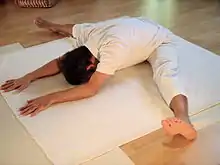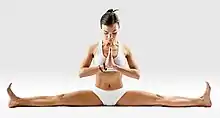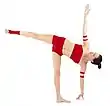Upaviṣṭa Koṇāsana
Upaviṣṭa Koṇāsana (Sanskrit उपविष्टकोणासन), also written Upavistha Konasana or "wide-angle seated forward bend",[1][2] is an asana in modern yoga as exercise, sitting upright with the legs as wide apart as possible, grasping the toes and leaning forward.[3]

Etymology and origins
The name of the pose is from the Sanskrit उपविष्ट (upaviṣṭa) meaning "open", कोण (koṇa) meaning "angle", and आस (āsana), meaning "seat" or "pose".[3]
The pose is not found in medieval hatha yoga, but is described in the 1966 Light on Yoga.[4] It is independently described under a different name, Hastapadasana ("Hand-to-Foot Pose"[lower-alpha 1]) in Swami Vishnudevananda's 1960 Complete Illustrated Book of Yoga, suggesting an older origin.[5]
Description

The pose may be entered from dandasana (staff pose) by moving the legs apart as far as possible. The big toes may then be grasped with the hands, or with a belt around each foot. The back is lightly arched by raising the coccyx, and the body is inclined forwards.[6][3][4][2] In the completed pose, the body leans forwards until the chin and nose touch the ground.[3] People who cannot sit on the floor in dandasana can sit on a folded blanket for the pose.[1]
Variations
Parsva Upavistha Konasana, the side variation, has the body facing one leg, and the hands both grasping the foot of that leg, without raising the opposite hip.[7]
Urdhva Upavistha Konasana, the upwards variation, is similar to Ubhaya Padangusthasana but with legs wide. It has the first and second fingers grasping the big toes, the legs wide apart, straight, and raised to around head height; the body is tilted back slightly to balance on the sitting bones. The pose can be practised with a strap around each foot if the legs cannot be straightened fully in the position; a rolled blanked can be placed behind the buttocks to assist with balancing.[8]
Claimed benefits
The pose provides a stretch for the hamstrings,[4] and is stated without evidence in Light on Yoga to assist the circulation in the pelvic region and to relieve sciatica.[4] The pose is stated, again without evidence, to be useful for "gynaecological problems",[3] and safe in both menstruation and pregnancy provided no strain is applied.[3] However, the founder of Ashtanga Vinyasa Yoga, K. Pattabhi Jois, states that it should not be performed in pregnancy, though agreeing on its benefit for the sciatic nerve.[9]
See also
Notes
- Hastapadasana is otherwise a synonym of the standing Forward Bend, uttanasana.
References
- Rosen, Richard (28 August 2007). "Wide-Angle Seated Forward Bend". Yoga Journal. Retrieved 18 November 2018.
- "Wide-Angle Seated Forward Bend - Upavishta Konasana". Ekhart Yoga. 2018. Retrieved 19 November 2018.
- Mehta, 1990 p. 65
- Iyengar, 1979, pp. 163–165
- Sjoman, Norman E. (1999) [1996]. The Yoga Tradition of the Mysore Palace (2nd ed.). Abhinav Publications. p. 88. ISBN 81-7017-389-2.
- Botur, Amanda. "Wide-Angle Seated Forward Bend • Upavistha Konasana". Yoga Today. Retrieved 19 November 2018.
- "Parsva Upavistha Konasana (Side Seated Wide Angle Pose)". Yoga Vastu. Retrieved 25 June 2021.
- "Upward Facing Wide-Angle Seated Pose - Urdhva Upavistha Konasana". Ekhart Yoga. Retrieved 25 June 2021.
- Jois, K. Pattabhi (2010). Yoga Mala: The Seminal Treatise and Guide from the Living Master of Ashtanga Yoga. Farrar, Straus and Giroux. p. 96. ISBN 978-1-4299-6506-4.
Sources
- Iyengar, B. K. S. (1979). Light on Yoga. Unwin Paperbacks.
- Lidell, Lucy; The Sivananda Yoga Centre (1983). The book of yoga. Ebury. ISBN 978-0-85223-297-2. OCLC 12457963.
- Mehta, Silva; Mehta, Mira; Mehta, Shyam (1990). Yoga: The Iyengar Way. Dorling Kindersley.
{{cite book}}: CS1 maint: multiple names: authors list (link) - Murugan, Chillayah (20 October 2012). "Yoga Asanas for Health and Fitness". Silambam. Archived from the original on 3 October 2015. Retrieved 31 May 2013.
- Swami Satyananda Saraswati (1996). Asana Pranayama Mudra Bandha (PDF). Yoga Publications Trust. ISBN 978-81-86336-14-4.
_from_Jogapradipika_1830_(detail).jpg.webp)
